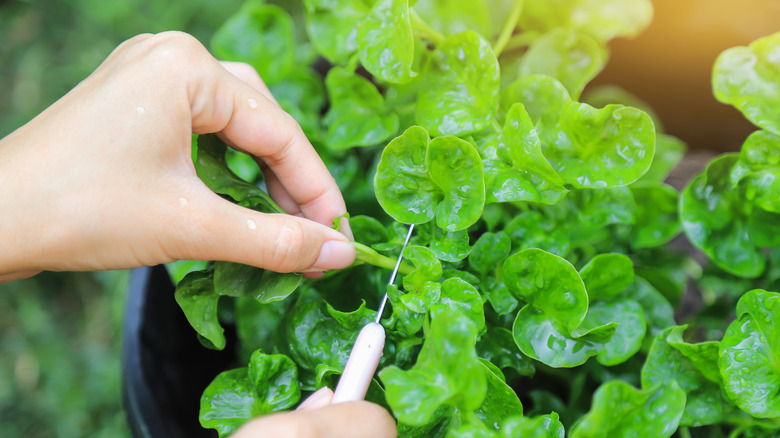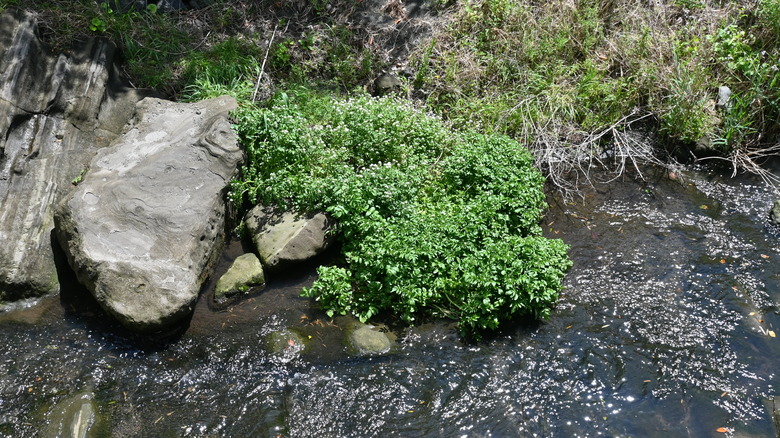How To Grow Watercress In Containers To Avoid Invasion & Add To Your Kitchen
Many of us add the peppery leaves of watercress to salads to add flavor and reap the many nutritional benefits. However, invasiveness is a significant consideration when it comes to growing watercress yourself. In fact, it's the main reason you may want to reconsider planting watercress in your garden. Thankfully, at least in a cultivated setting, planting this pesky yet tasty leafy green in pots means it can't easily escape. If you already have a babbling brook, waterfall, or pond in your backyard, simply pop some pots of watercress seedlings in there and watch them thrive. Or, and this is a far more achievable method for most, you can also grow watercress seedlings in a regular pot sitting in a dish of water — both indoors or out.
The scientific name for the watercress species under discussion in this article is Nasturtium officinale. You might know it by other names such as; Eker, biller, bilure, rib cress, brown cress, teng tongue, long tails, or well grass. This Old World perennial (in the wild, at least) was originally imported to the U.S.A. from Europe at some point over the past few centuries. It thrives in shallow freshwater and boggy soil so long as the water is refreshed often and not stagnant. It has button-cute white flowers from spring through fall. Nowadays, you can find it in the wild and gardens in almost every U.S. state since it thrives in USDA Hardiness Zones 3 to 11. In hotter climates, it doesn't get as peppery as plants grown in the north.
Understanding the invasiveness of watercress
It's worth noting that there are several native watercress species, for example, Rorippa floridana, and they aren't all considered invasive. Common watercress is such a problem because of its ability to multiply — and quickly. The plants are self-pollinating, and a single flower head produces 15 seed pods, each with 16 seeds apiece. What's more, branches produce new roots super efficiently, meaning the plant spreads out over the meandering stream or natural spring where it got its start. Once established, the thick mat of vegetation makes it increasingly difficult for other native aquatic plants to thrive. Watercress also has some pretty impressive defensive strategies.
The species is in the mustard or Brassicaceae family and, like its cousins — radishes, arugula, and kale, among many others — is a little spicy. The distinctive taste and smell are created by oils that activate when the plant is attacked by large and microscopic predators or dominated by competitors. It's a rather dramatic yet highly effective reaction botanists have dubbed the myrosinase-glucosinolate bomb. Since little can thrive in a patch of watercress, it's detrimental to the overall health of a wild aquatic ecosystem and your garden alike.
Are you proud of your ability to grow a thriving tomato crop? Watercress' defensive capabilities make it one plant you definitely won't want too close to your tomatoes this year. It's also toxic to dogs, cats, and horses, so if you have pets prone to nibbling your potted plants, you should probably avoid growing this particular aquatic greenery.
The easy how-to for growing watercress in a planter
Watercress seeds and seedlings are available at specialty nurseries across the U.S. Peaceful Valley Farm & Garden Supply sells a 100-seed packet of USDA Certified Organic watercress for $3.99. If you prefer ready-to-plant seedlings, Crimson Sage Medicinal Plant Nursery sells them for $7.50 each. You can also root cuttings from neighbors' plants or fresh, green supermarket bunches. Watercress likes its feet wet so you'll need to simulate a stream or bog to grow it properly. Fill a medium-sized planter with compost or a good quality potting mix, sow the watercress seeds or plant the seedlings, and place the pot in a dish or bucket filled with two or three inches of water. Put the planter-dish combo in a sunny spot, ideally, though somewhere with dappled shade works, too. Seeds should sprout in around five days.
Fertilize your new watercress patch with one cup of garden fertilizer for every 25 square feet of soil, and change the water each week using rainwater or bottled water. You can also grow watercress in a water feature or pond, as previously stated. Use aquatic pots — they have holes in them to let the water through, making them look like plastic sieves — or planters with ample drainage holes. Don't have outdoor space? Simply upcycle old takeaway containers and grow seedlings on your kitchen windowsill. Once you have the watercress container growing method down, try this fun gardening project: This tasty cress is among the edible plants you can grow in an outdoor hydroponic garden.

